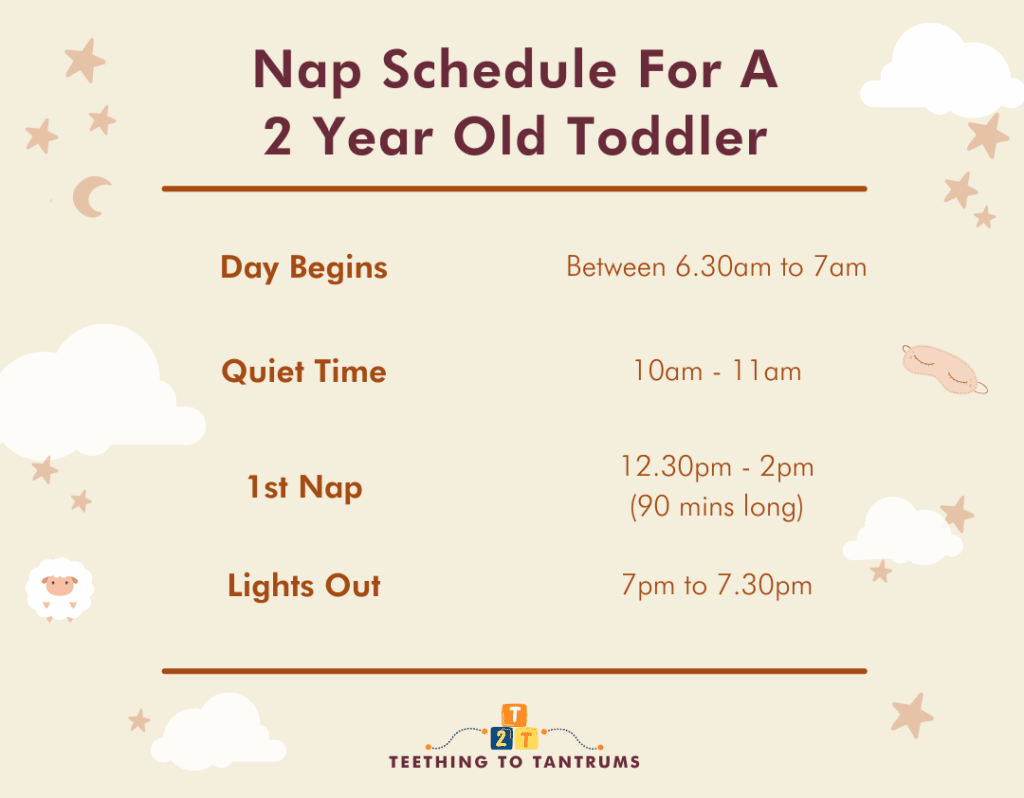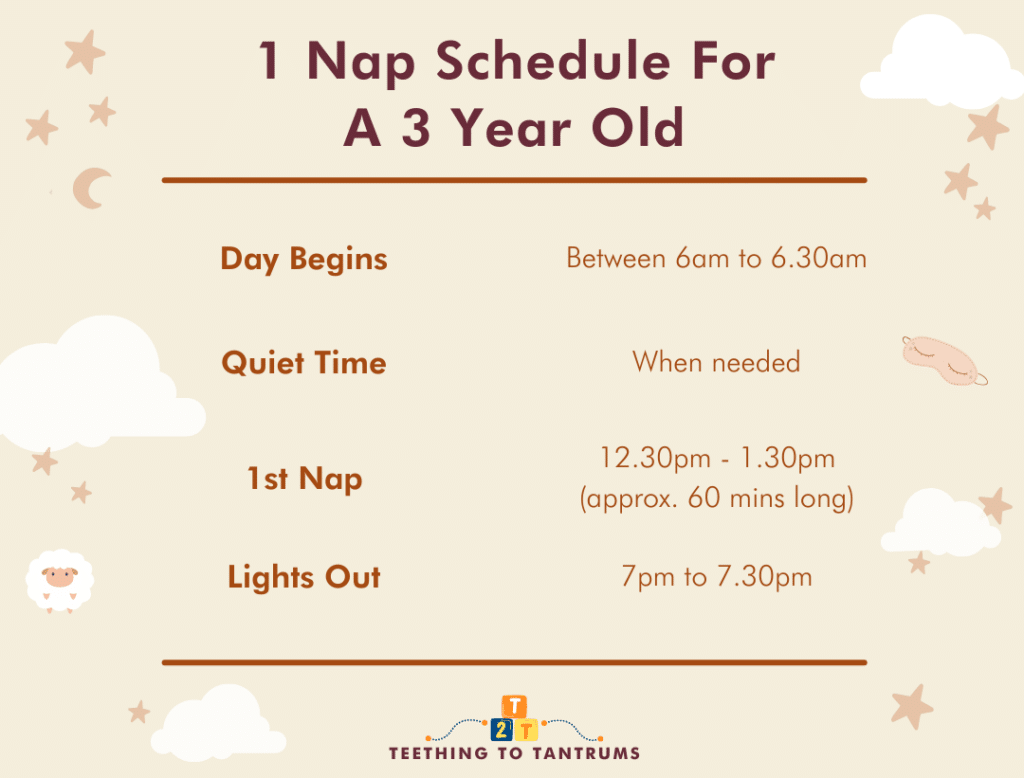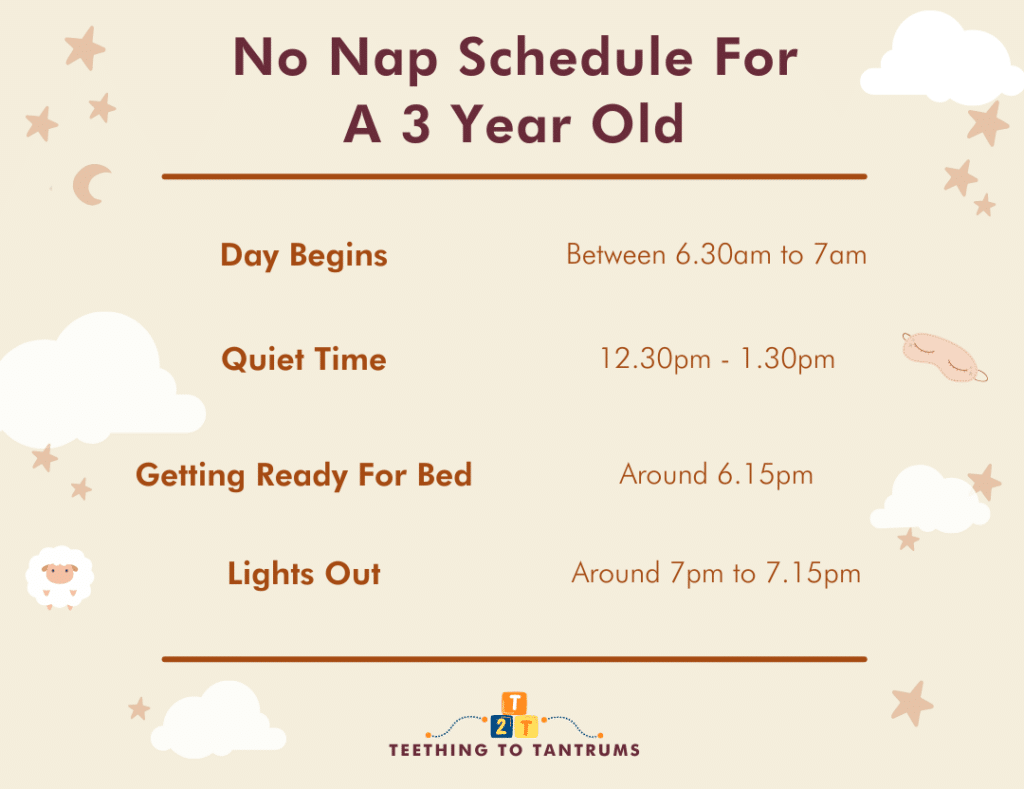Sleep is a pillar of your child’s well-being. It supports growth, learning, and overall mood. That’s why understanding your toddler’s sleep needs and creating a suitable toddler nap schedule is CRUCIAL.
Get sleep right and you will enjoy this wonderful stage so much more. There will be fewer meltdowns and tantrums and your toddler will be able to embrace this new stage in their development with enthusiasm and energy.
In today’s article, I will share with you the best toddler nap schedule, no matter their age, ensuring healthy development and a well-rested family!

Table of Contents
How Much Sleep Do Toddlers Need?
Generally, toddlers require 12 hours of sleep in 24 hours. This includes nighttime sleep and daytime naps.
Here is a guideline for your toddler’s sleep requirements, including appropriate nap lengths:
| Age Of Toddler | Total Sleep Required In 24 Hours | Daytime Sleep (Naps) |
| 1-2 years | 11-14 hours | 2-3 hours (split over 1-2 naps) |
| 2-3 years | 11-14 hours | 1-3 hours (split over 1-2 naps) |
| 3-4 years | 10-13 hours | 0-1 hours (1 nap) |
As toddlers grow, it is important to appreciate that their sleep needs will change.
While younger toddlers may still require two naps during the day, older toddlers often transition to just one midday nap.
This is part of their journey towards daytime sleep diminishing entirely as nighttime sleep consolidates.
NOTE: I always emphasize that a toddler nap schedule is more than just a break in their daily routine but a fundamental part of their sleep needs. That means that even if your toddler drops their daytime nap as early as 2-3 years of age, the total amount of sleep should remain around 12 hours at night.
How Many Naps Does A Toddler Need?
For toddlers aged 1 to 2 years, two naps a day is ideal. Each nap may vary from 1 to 2 hours in length.
By the time they reach 18 months, many toddlers need 2 naps on busy days but will begin transitioning to one nap per day on calmer days.
The transition to one daily nap consistently usually occurs between 3 to 4 years old (but I have known lots of 2 to 3-year-olds who only nap once a day)
It is important for your child’s development that they receive adequate daytime sleep or rest by encouraging quiet time after lunch.
TOP TIP: Observing your little one’s sleep cues and responding accordingly will help you get the timing of daytime sleep and bedtimes right. This is especially important on busy days or if your little one is unwell as they may then need more sleep during the day. This could be in the form of a longer daytime nap or an extra catnap.
2-Year-Old Sleep Schedule Guidelines
I love the toddler phase. Even with all its challenges of growing independence and what appears to be an endless energy for exploring their zest for life is so refreshing and never fails to bring me joy.
However, I have also learned that getting toddler sleep right will impact your enjoyment and appreciation of this age.
A well-rested toddler is a delight… but an overtired toddler will be a challenge to manage.
Your toddler’s sleep schedule is therefore vital for their development and well-being and at 2 years old, a balance of nighttime sleep and daytime naps is key to ensure they get enough total rest and can make the most of their waking hours.
An ideal sleep schedule incorporates a consistent bedtime and nap routine and wake time.
However, no matter how well-structured your sleep schedule is there may be times when you hit a rough patch. This could be due to your child experiencing a big change in their daily life such as the arrival of a new sibling, starting daycare, or a sleep regression.
During these phases, it might become challenging to stick to a toddler nap schedule.
Sleep regression while being a natural part of your little one development can lead to resistance to napping, but it’s important to be patient and consistent with nap times during this phase.
Stick to the schedule and be prepared to substitute quiet times for nap times or bring bedtime forward to avoid overtiredness.
Here’s a simplified guide to understanding your 2-year-old’s sleep needs:
- Ideal Amount of Daytime Sleep: Aim for 1 to 3 hours of naptime. This helps your toddler reach the total hours of sleep needed each day.
- Average Number of Naps: Most 2-year-olds require one nap per day. This typically happens shortly after lunch. A short 30-minute cat nap before dinner might be required on busy days.
- Number and Length Of Wake Windows: Look for signs of sleepiness after about 5-6 hours of wakefulness to schedule the nap.
- Ideal Bedtime: An appropriate bedtime often ranges between 7:00 pm to 8:00 pm, depending on your child’s specific needs including how they have napped during the day.
Sample 2-Year-Old Sleep Schedules
When organizing your 2-year-old’s sleep schedule, consistency is key.
Aim for a predictable bedtime and morning wake-up. This not only helps establish a routine but also ensures your child gets the recommended amount of sleep.
Here is an example 2-year-old toddler nap schedule:
- 6.30-7 am – Wake up
- 10-11 am – Quiet time
- 12.30 pm – 2.30 pm: Naptime
- 6-6.30 pm: Bedtime routine
- 7 pm – Lights out

TOP TIP: Remember to adjust your toddler nap schedule based on your toddler’s specific needs and signs of tiredness. Each child is different, and sleep requirements can vary.
3-Year-Old Sleep Schedule Guidelines
By the time your toddler is three years of age, they may be showing signs of not needing to nap at all. However, consistent sleep schedules are still the cornerstone for healthy growth and development.
Psychologists emphasize the role of reliable sleep patterns in supporting both emotional and cognitive development at this age.
Below is a guideline to help you establish a sleep schedule that fosters good sleep habits for your 3-year-old toddler:
- Ideal Amount of Daytime Sleep: A 3-year-old typically needs about 1 to 2 hours of naptime during the day.
- Average Number of Naps: Most 3-year-olds have one nap per day. Some may not need to nap but should have a quiet time after lunch instead.
- Number and Length Of Wake Windows: The time between waking up in the morning and naptime, and then from naptime to bedtime, should be about 5.5 to 6 hours.
- Ideal Bedtime: Depending on their wake time, a suitable bedtime for a 3-year-old ranges from 7-7.30 pm.
TOP TIP: You should always account for bedtime resistance, which can often emerge at 3 years of age, and adjust your toddler’s nap schedule as needed to ensure they get enough rest. Respond to sleep cues by adjusting naptimes and bedtimes if necessary.
Sample 3-Year-Old Sleep Schedules
As always, when organizing a toddler nap schedule, consistency is key… even when your 3-year-old is in the process of dropping their daytime nap.
Here are 2 examples of a toddler nap schedule for a 3-year-old who is transitioning from 1 to no daytime naps.
One Daytime Nap Scheule
- 6-6.30 am – Wake up
- As needed – Quiet time
- 12.30 pm – 1.30 pm: Naptime
- 6-6.30 pm: Bedtime routine
- 7 pm – Lights out

No Daytime Nap Schedule
- 6-6.30 am – Wake up
- 12.30 pm – 1.30 pm: Quiet time
- 6-6.30 pm: Bedtime routine
- 7-7.15 pm – Lights out

4-Year-Old Sleep Schedule Guideline
At four years old, your child’s sleep needs are unique to their development.
Interestingly, The Sleep Foundation states that ‘Sixty percent of four-year-olds still nap. However, by five years of age, most children no longer need naps, with less than 30% of children that age still taking them.‘
Here’s a guide to understanding your 4-year-old’s sleep needs:
- Ideal Amount Of Daytime Sleep: Up to 1 hour. May phase out naps.
- Average Number Of Naps: Often zero as many children transition out by this age. Will still benefit from quiet time and may need a quick nap on very busy days
- Number And Length Of Wake Windows: Typically 11-12 hours of awake time. Wake windows can now stretch from morning wake-up to bedtime
- Ideal Bedtime: Between 7:.00 and 8:00 PM for sufficient night’s rest
Sample 4-Year-Old Sleep Schedules
All young children thrive with a regular and stable routine. When creating a sleep schedule for your 4-year-old, it can look like the following:
Morning Routine:
- 7:00 AM – Wake up and have breakfast
- 7:30 AM – Get ready for the day
Daytime Rest:
- 1:00 PM – Quiet time (or a nap for those who need it)
- 2:00 PM – Playtime or activities
Evening Routine:
- 5:30 PM – Dinner
- 6:00 PM – Quiet activities, such as reading a book or doing a puzzle
- 6.30 PM – Begin the bedtime routine
- 7:30 PM – Lights out
Looking to get your little one to sleep quickly and effortlessly? Check out my Bedtime and Nap Cheat Sheet and master the art of making daytime naps and bedtimes as seamless as possible.
A bedtime & nap cheat sheet so good your little one will ask you to put them to bed...
Laura Williams "This is a life saver! I'm so glad I downloaded your bedtime & nap cheat sheet. My little one actually asked me to put him to bed last night! Unbelievable! Thank you so much!"
Click Here For The FREE Cheat Sheet
Top Tips for Maintaining a Healthy Nap Schedule
Throughout all my years of experience, I have found many tips and tricks that have been very helpful in managing toddler nap times. The first of which I will never stop teaching parents…
- Maintain a consistent and recognizable bedtime routine. As I am always saying you cannot look at daytime sleep without looking at nighttime sleep too. That is why having a recognizable bedtime routine that happens at the same time every day is so important. Daytime sleep will go so much more smoothly if your little one is sleeping well at night.
- Have regular nap times with a pre-nap routine. A pre-nap routine is just as important as a bedtime routine. It signals to your little one that sleep is coming up and will help them be more prepared to drift off.
- Utilise quiet time. During nap transitions and if your toddler is resisting nap time, encourage a quiet time instead. As your toddler grows, quiet time after lunch should still be part of your routine even when your child stops napping during the day. This is a time to slow down and recharge the batteries before taking on the rest of the day.
- Manage transitions. When your toddler is tired (i.e. leading up to nap time) managing the transition from mealtime or playtime to sleep time is crucial. Toddlers do not like to be rushed so take things slowly, lower the energy, and stick to a recognizable pre-nap routine that is not too long.
- Don’t be afraid to wake your toddler from a nap. This is very important. To keep your nap schedule on track, remember it is OK to wake your toddler from a daytime nap. Allowing your toddler to sleep too much during the day will impact on nighttime sleep so do not let them sleep for more than 2.5 to 3 hours during the day.
- Alternatively… Don’t keep your toddler awake to fit the nap schedule. If your toddler is showing signs of being tired at a time that they would not normally nap, let them sleep – even if it is just a cat nap. Watch for signs of sleepiness like rubbing eyes, irritability, or yawning. When you notice these signs, it’s time to begin the nap routine. Catching these early ensures that your toddler isn’t overtired which can make it harder for them to fall asleep.
- Ensure you create a cozy sleep environment conducive to nap time sleep. The sleep environment for naps is just as important as at bedtime. Use black out blinds to reduce light preventing sleep and a white noise machine to stop household noises from disturbing your little one.
- Get outside every day. Exposure to fresh air and natural light has been proven to help with sleep. It balances their circadian rhythm and melatonin production. It also ensures that your toddler gets the opportunity for plenty of physical exercise.
- Encourage your toddler to be active and engaged when they are awake. During wake periods ensuring that your toddler is active and engaged will help them be more ready for nap times. It is also important that they get plenty of opportunities to practice any new skills they might be learning.
- Consider using gentle sleep training techniques. If your toddler struggles with naps, sleep training methods can be beneficial. Choose a technique that you are comfortable with, and be patient and consistent with its application. Bear in mind that it may take time for your toddler to adapt to the training.
The Importance Of Quiet Time In A Toddler Nap Schedule
I am a great fan of quiet time and in my experience, having quiet time after lunch every day is a great habit to establish that encourages your toddler to rest and without the pressure to sleep.
I have looked after toddlers who dropped daytime sleep before their second birthday and others who still needed a 2-hour nap well into their third year…
Quiet time is your savior as it ensures that your toddler slows down for a period each day that allows them to recharge their batteries and not become overtired.
It also encourages independent play and is proven to improve cognitive and creative development.
Frequently Asked Questions About Creating A Toddler Nap Schedule
Navigating your toddler’s nap schedule can be quite a puzzle. This section aims to address your concerns with straightforward answers.
Q: When do toddlers stop napping?
A: Typically, toddlers transition away from napping altogether between ages 3 to 5. This change depends on your child’s own development and activity levels. Signs that they are ready to stop may include difficulty falling asleep at naptime or bedtime.
Q: Why do toddlers need to nap?
A: Naps are crucial for your toddler’s growth, daily functioning, and mood. They help with learning, memory, and processing new skills. During the toddler stage, sufficient daytime sleep is just as important as a good night’s rest.
Q: Should you keep a toddler on a nap schedule?
A: Keeping a predictable nap schedule helps your toddler’s body get the rest it needs consistently. Regular naps can reduce fussiness and maintain a stable mood. You need to observe your child’s sleep cues to best structure their naps.
Q: Why do toddlers refuse to nap?
A: Refusal to nap can stem from various reasons such as increasing independence, overstimulation, or changes in routine. Ensure the sleep environment is calming and consistent. An overtired toddler may also resist napping, so timing is key to avoiding this struggle.
Q: How many hours of afternoon nap is ideal for a 2-year-old?
A: An ideal afternoon nap for a 2-year-old ranges from 1 to 2 hours. This supports their total daily sleep need of 11 to 14 hours. Observe your child’s behavior to determine what duration helps them wake up refreshed and happy.
Q: At what time of day should a 3-year-old be put down for a nap?
A: A 3-year-old typically benefits from a nap starting early afternoon, around 1 to 2 PM. This time allows for optimal sleep following lunch and avoids interfering with evening sleep. The specific time may vary based on your child’s wake-up time and individual needs.
Q: How do you adjust a 4-year-old’s sleep schedule as they phase out napping?
A: To adjust a 4-year-old’s sleep schedule, you can gradually push nap times later or shorten them. Begin to introduce quiet time during regular nap times to transition smoothly. Pay close attention to their evening sleep quality and overall mood, making changes as necessary.
Need More Parenting Help?
- Download our FREE Bedtime & Nap Sleep Cheat Sheet. It’s a free, easy-to-use and proven formula designed for parents of 0-5 year olds to master the art of consistently undisturbed and restful sleep without the yelling, nagging or exhausting long-winded evenings.
- Check out our Parenting Toolbox. You’ll get access to expertly-chosen products that you can guarantee are the best for your little one and your wallet.
- Are you looking for personalized guidance to navigate the challenges of parenting? I offer 1-on-1 consultations to bring you tailored strategies and actionable advice to help support your child's growth and well-being with confidence.

A bedtime & nap cheat sheet so good your little one will ask you to put them to bed...
Laura Williams "This is a life saver! I'm so glad I downloaded your bedtime & nap cheat sheet. My little one actually asked me to put him to bed last night! Unbelievable! Thank you so much!"
Click Here For The FREE Cheat Sheet


